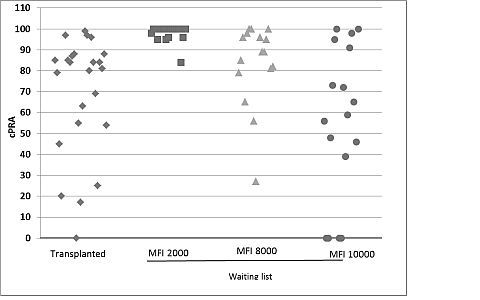Limits of Paired Donation – Who Doesn’t Get Transplanted?, The
Transplant Surgery, Mayo Clinic, Rochester, MN
Nephrology, Mayo Clinic, Rochester, MN
Transplant Surgery, Mayo Clinic, Scottsdale, AZ
Nephrology, Mayo Clinic, Scottsdale, AZ
Meeting: 2013 American Transplant Congress
Abstract number: A828
Introduction: Kidney paired donation (KPD) aims to provide compatible donors for ABO incompatible (ABOi) or +XM candidates. However, donors with rare HLA types or blood group O are uncommon. The study aimed to determine which patients remain untransplanted in our KPD program.
Methods: We retrospectively reviewed all transplants (Tx) from our 2-site KPD program between 2007 and 2012. Computerized matching criteria required: blood group compatibility; anti-donor HLA antibody mean fluorescence index (MFI) <2000; and a negative T and B cell flow cytometric crossmatch.
Results: 80 KPDs were performed including: 36 in the ABOi group,26 in the +XM group and 18 for other reasons (ex. CMV mismatch). Median time to Tx was 12 months. 50% (10/20) of the ABOi recipients transplanted were blood group O while 100% (9/9) of those still waiting were O. Of the patients transplanted in the +XM group, 84.6% had a cPRA <90% (22/26, Figure). Of the +XM still waiting, 94.4 % (17/18), had a cPRA >90%. When the “acceptable” MFI was increased to 8000, 58.8% (10/17) of the remaining +XM patients now had a cPRA <90% and thus would be more likely to be transplanted in KPD, albeit with a +XM. 41% of the cPRA>90% group likelywould not be transplanted.

Conclusions: These data highlight the limits of KPD and help guide patient management. O recipients with low anti-donor blood group titers might consider ABOi Tx while those with high titers will most likely have to wait longer for a KPD or a deceased donor Tx. Candidates with a cPRA <90% should probably remain in the program until they receive a –XM Tx. Requiring a negative XM severely limits the number of transplants in patients with a cPRA >90% (only 22% were transplanted). Increasing the “acceptable” MFI and performing a +XM kidney transplant may be their best option. Candidates with a combination of a high cPRA and high levels of alloantibody will likely never receive a transplant unless new therapy to deplete alloantibody production is developed.
Stegall, M.: Grant/Research Support, Alexion, Millennium.
To cite this abstract in AMA style:
Li H, Stegall M, Reddy K, Casey E, Dean P, Heilman R, Cosio F, Khamash H, Prieto M. Limits of Paired Donation – Who Doesn’t Get Transplanted?, The [abstract]. Am J Transplant. 2013; 13 (suppl 5). https://atcmeetingabstracts.com/abstract/limits-of-paired-donation-who-doesnt-get-transplanted-the/. Accessed December 9, 2025.« Back to 2013 American Transplant Congress
